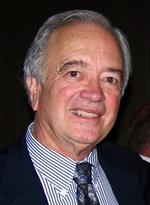Clement
Furlong
PhD

(206) 543-1193
University of Washington
Health Sciences Building, Rm I-204
Box 357360
Seattle, WA 98195-7360
biography
Dr. Furlong received a B.A. in Chemistry from San Jose State College in 1963 and a Ph.D. in Biochemistry from the University of California, Davis in 1968 where he studied the allosteric regulation of glycogen synthesis in bacteria. He then spent two postdoctoral years at Cornell University, Ithaca, N.Y. with Dr. Leon Heppel working on bacterial ABC transporters, isolating and characterizing a number of periplasmic substrate binding proteins. In 1970, he continued this research as a faculty member in the Biochemistry Department at the University of California, Riverside. In 1976 he spent a sabbatical leave at Stanford University working with Drs. Harden McConnell and Hugh McDevitt studying immunology. In 1977, Dr. Furlong joined the UW Departments of Medicine (Division of Medical Genetics) and Genetics (now Genome Sciences) as a Research Associate Professor. He was promoted to Research Professor in 1992 and Professor in 2011.
Education & Training
B.A. Chemistry, San Jose State College, San Jose, CA (1963)
Ph.D., University of California, Davis, CA (1968)
Postdoctoral training, Cornell University, Ithaca, NY (1968-1970)
Research Interests
1) Gene/environment interactions, particularly the role the paraoxonase family of genes (PONs 1,2 &3) in modulating oxidative stress, exposure to organophosphorus insecticides and risk of cardiovascular disease.
2) Development of mouse models to validate the gene x environment interaction studies.
3) Development of mass spectrometric-based protocols for characterizing biomarker proteins to measure levels of exposure to organophosphorus compounds.
4) Generation of recombinant proteins in an E. coli expression system
5) Development of portable biosensor systems based on surface plasmon resonance (SPR) and associated protocols for detection of specific analytes including small organics, proteins, nucleic acids, viruses and microbes.
Publications
Davies H, Richter RJ, Keifer M, Broomfield C. Sowalla J, Furlong CE. The effect of the human serum paraoxonase polymorphism is reversed with diazoxon, soman and sarin. Nature Genetics 14:334-336, 1996.
Shih DM, Gu L, Xia YR, Navab M, Li WF, Hama S, Castellani LW, Furlong CE, Costa LG, Fogelman AM, Lusis AJ. Serum paraoxonase knockout mice are susceptible to organophosphate insecticides and lipoprotein oxidation. Nature 394:284-287, 1998.
Li WF, Costa LG, Richter RJ, Hagen T, Shih DM, Tward A, Lusis AJ, Furlong CE. Catalytic efficiency determines the efficacy of PON1 for detoxifying organophosphates. Pharmacogenetics 10:767-780, 2000.
Cole TB, Jampsa RL, Walter BJ, Arndt TL, Richter RJ, Shih DM, Tward A, Lusis AJ, Jack RM, Costa LG, Furlong CE. Expression of human paraoxonase (PON1) during development. Pharmacogenetics 13:357-364, 2003.
Jarvik GP, Jampsa R, Richter RJ, Carlson C, Rieder M, Nickerson D, Furlong CE. Novel paraoxonase (PON1) nonsense and missense mutations predicted by functional genomic assay of PON1 status. Pharmacogenetics 13:291-295, 2003.
Costa LG, Cole TB, Jarvik GP, Furlong CE. Functional Genomics of the Paraoxonase (PON1) Polymorphisms: Effects on Pesticide Sensitivity, Cardiovascular Disease, and Drug Metabolism. Ann Rev Med 54:371-392, 2003.
Richter RJ, Jarvik GP, Furlong CE. 2008. Determination of Paraoxonase 1 (PON1) Status without the Use of Toxic Organophosphate Substrates. Circ Cardiovasc Genet 1:147-152. PMID: 20031556 [PubMed - indexed for MEDLINE] PMCID: PMC3035628 See also editorial: Loscalzo J. Paraoxonase and coronary heart disease risk – language misleads, linkage misinforms, function clarifies. Circ Cardiovasc Genet. 1(2):79-80
Cole TB, Beyer RP, Bammler TK, Park SS, Farin FM, Costa LG, Furlong CE. 2011. Repeated developmental exposure of mice to chlorpyrifos oxon is associated with paraoxonase 1 (PON1)-modulated effects on cerebellar gene expression. Toxicol Sci 123(1):155-69.
Marsillach J, Hsieh EJ, Richter RJ, MacCoss MJ, Furlong CE. 2013. Proteomic analysis of adducted butyrylcholinesterase for biomonitoring organophosphorus exposures. Chem Biol Interact 203(1):85-90.
Giordano G, Tait L, Furlong CE, Cole TB, Kavanagh TJ, Costa LG. 2013. Gender differences in brain susceptibility to oxidative stress are mediated by levels of paraoxonase-2 expression. Free Radic Biol Med 58:98-108.
Costa LG, de Laat R, Dao K, Pellacani C, Cole TB, Furlong CE. 2014. Paraoxonase-2 (PON2) in brain and its potential role in neuroprotection. Neurotoxicology 43:3-9
Cole TB, Li W-F, Co AL, Hay AM, MacDonald JW, Bammler TK, Farin FM, Costa LG, Furlong CE. 2014. Repeated gestational exposure of mice to chlorpyrifos oxon is associated with paraoxonase 1 (PON1)-modulated effects in maternal and fetal tissues. Toxicol Sci 141(2):409-22
Marsillach J, Becker JO, Vaisar T, Hahn BH, Brunzell JD, Furlong CE, deBoer IH, McMahon MA, Hoofnagle AN. 2015. Paraoxonase-3 is depleted from the high density lipoproteins of autoimmune disease patients with subclinical atherosclerosis. J Proteome Res 14(5):2046-54
Marsillach J, Costa LG, Furlong CE. 2016. Paraoxonase-1 and early life environmental exposures. Ann Glob Health 82(1):100-10
Furlong CE, Marsillach J, Jarvik GP, Costa LG. 2016. Paraoxonases-1, 2 and 3: What are their Functions? Chem Biol Interact 259(Pt B):51-62.



